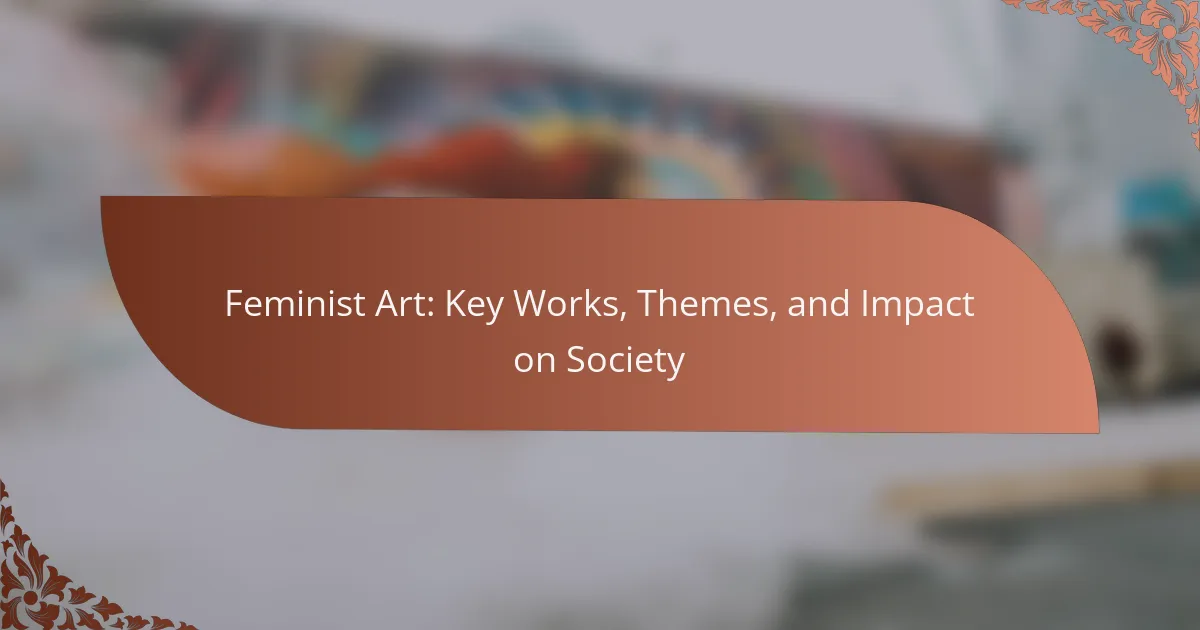Feminist art plays a crucial role in promoting gender equality and challenging traditional representations of women. It explores themes of empowerment, intersectionality, and body politics. Key works like “The Dinner Party” and “Your Body is a Battleground” have significantly influenced societal perceptions of feminism. This article examines the evolution of feminist art, its key themes, notable works, and its ongoing impact on society.
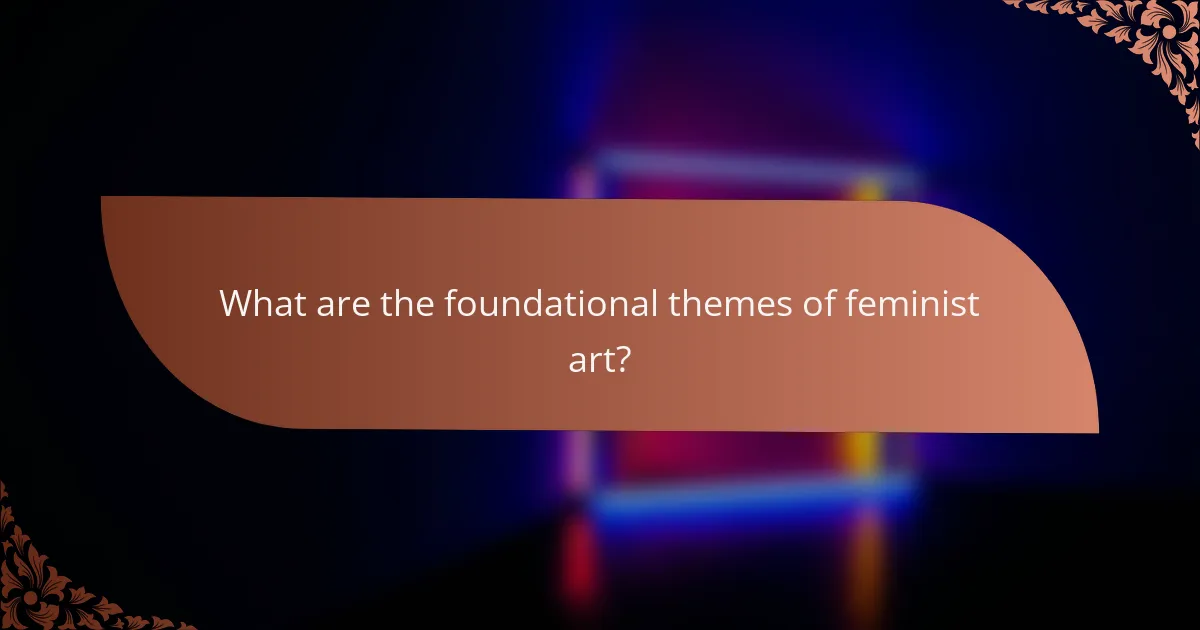
What are the foundational themes of feminist art?
Feminist art focuses on themes of gender equality, identity, and social critique. It challenges traditional representations of women and highlights female experiences. Key themes include empowerment, body politics, intersectionality, and the critique of patriarchy. These themes reflect societal issues and promote dialogue around women’s rights and representation in art.
How do feminist artists challenge traditional narratives?
Feminist artists challenge traditional narratives by subverting gender roles and highlighting women’s experiences. They use diverse media to critique societal norms and advocate for equality. For example, artists like Judy Chicago and Barbara Kruger employ visual storytelling to confront patriarchal structures. Their work often reclaims female identity, transforming historically male-dominated art forms into platforms for feminist discourse. This shift not only influences contemporary art but also fosters broader societal change by encouraging critical conversations about gender and power dynamics.
What role does intersectionality play in feminist art?
Intersectionality plays a crucial role in feminist art by highlighting diverse experiences of women. It emphasizes how overlapping identities, such as race, class, and sexuality, shape individual realities. This perspective enriches feminist art by fostering inclusivity and complexity. Artists like Kerry James Marshall and Frida Kahlo explore these intersections, challenging traditional narratives. Their works reflect the unique struggles faced by marginalized groups, ultimately expanding the discourse within feminist art.
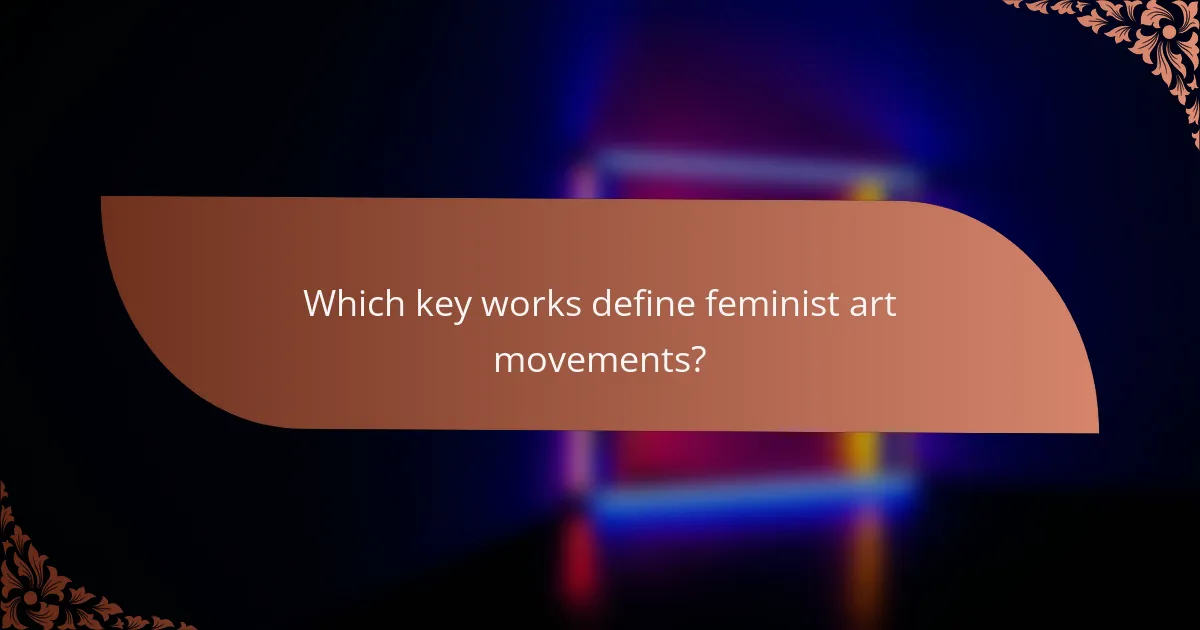
Which key works define feminist art movements?
Key works that define feminist art movements include “The Dinner Party” by Judy Chicago, “Untitled” by Barbara Kruger, and “Your Body is a Battleground” by Cindy Sherman. These pieces emphasize themes of gender, identity, and societal roles. “The Dinner Party” features place settings for notable women, highlighting women’s contributions to history. “Untitled” employs provocative text to challenge stereotypes, while “Your Body is a Battleground” addresses women’s rights and representation. Collectively, these works have significantly impacted societal perceptions of feminism and art.
How has Judy Chicago’s “The Dinner Party” influenced perceptions of women in art?
Judy Chicago’s “The Dinner Party” has significantly shifted perceptions of women in art by highlighting their historical contributions. This installation features place settings for 39 influential women, emphasizing their roles in society. As a result, it has inspired a broader recognition of female artists and feminist themes in contemporary art. Chicago’s work challenges traditional narratives and encourages dialogue about gender equality. Its impact is evident in increased visibility and appreciation for women’s art, making it a pivotal piece in feminist art history.
What significance does Barbara Kruger’s text-based art hold in contemporary discussions?
Barbara Kruger’s text-based art plays a crucial role in contemporary feminist discourse by challenging societal norms. Her work uses bold text to confront issues like gender, power, and identity, making complex ideas accessible. This approach emphasizes the intersection of art and activism, prompting viewers to reflect critically on cultural constructs. Kruger’s unique use of language as a visual element empowers marginalized voices, reinforcing the significance of feminist art in shaping societal conversations.
How does the work of Frida Kahlo reflect personal and political struggles?
Frida Kahlo’s work embodies personal and political struggles through vivid imagery and symbolism. Her art reflects her experiences with physical pain, identity, and gender. Kahlo’s self-portraits often portray her emotional turmoil and societal issues, making her a key figure in feminist art. The themes of suffering and resilience resonate deeply, highlighting the intersection of personal narrative and broader political contexts. Her unique approach challenges traditional gender roles, emphasizing women’s experiences and empowerment in a patriarchal society.
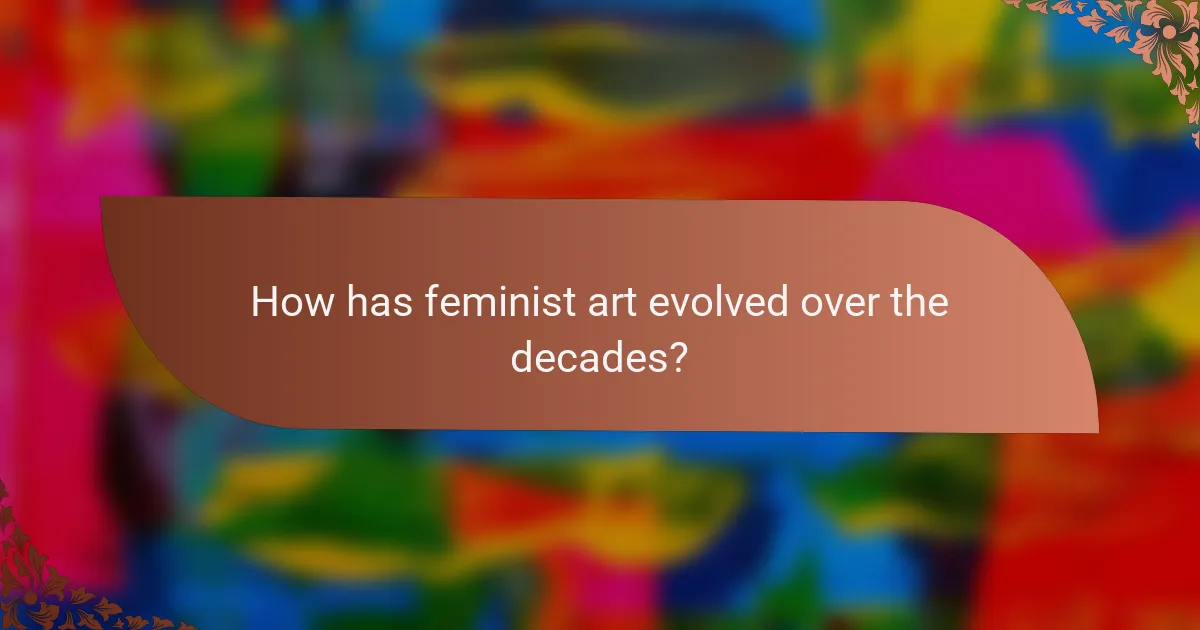
How has feminist art evolved over the decades?
Feminist art has evolved significantly over the decades, reflecting societal changes and women’s rights movements. In the 1960s and 1970s, the movement focused on challenging patriarchal norms and exploring gender identity. Key works included Judy Chicago’s “The Dinner Party,” which highlighted women’s contributions to history.
In the 1980s and 1990s, feminist art expanded to address intersectionality, incorporating race, class, and sexuality. Artists like Carrie Mae Weems and Lorna Simpson used photography and video to explore these themes. The 2000s brought a resurgence of feminist art, with contemporary artists addressing issues such as body politics and reproductive rights.
Today, feminist art continues to impact society by promoting dialogue around gender equality and representation. The movement’s evolution showcases its adaptability and relevance in addressing ongoing social issues.
What are the major milestones in feminist art history?
Major milestones in feminist art history include the emergence of women artists in the 1970s, the establishment of feminist art movements, and the recognition of women’s contributions to art. Key works include Judy Chicago’s “The Dinner Party,” which celebrates female figures in history, and Cindy Sherman’s photography, which critiques gender roles. The impact on society includes increased visibility for women artists and a challenge to traditional art narratives. These milestones have reshaped the art world and continue to influence contemporary discussions on gender and representation.
How has the digital age transformed feminist art practices?
The digital age has significantly transformed feminist art practices by enhancing accessibility and amplifying voices. Artists utilize social media to share their work, engage with audiences, and foster community. This shift has democratized art distribution, allowing diverse perspectives to emerge. Additionally, digital tools enable innovative forms of expression, blending traditional mediums with technology. As a result, feminist art now reaches wider audiences, challenging societal norms and sparking important conversations on gender equality.
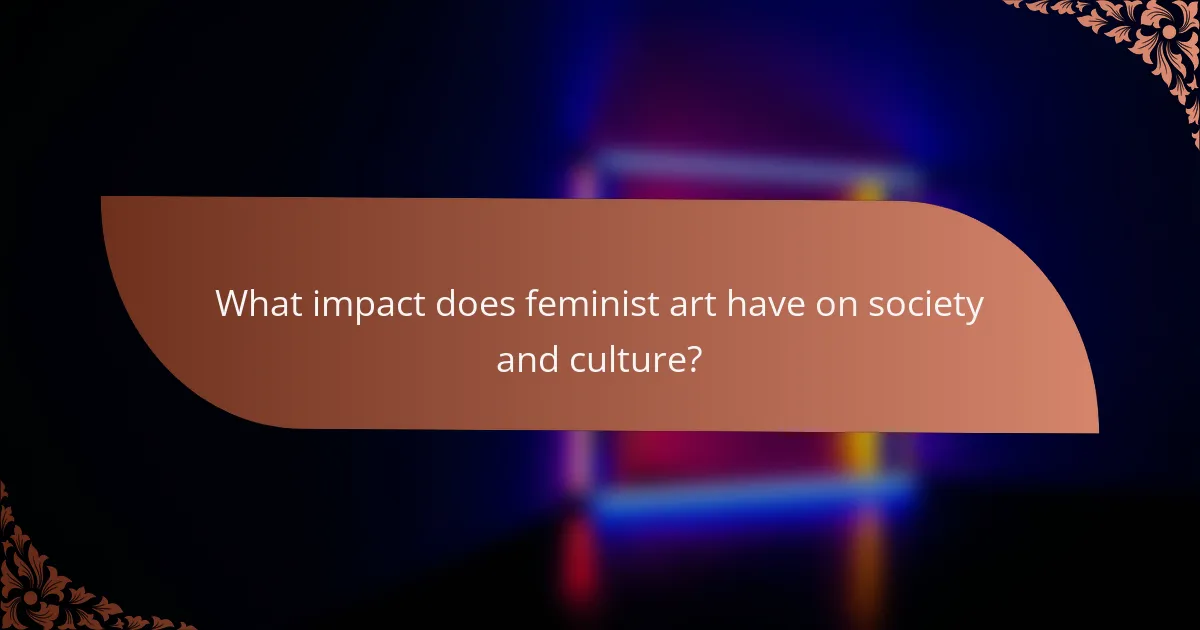
What impact does feminist art have on society and culture?
Feminist art significantly influences society and culture by challenging traditional gender roles and promoting equality. It encourages dialogue on women’s rights and representation while inspiring social change. Key works, like Judy Chicago’s “The Dinner Party,” highlight women’s contributions throughout history, fostering awareness and appreciation. Feminist art also addresses intersectionality, showcasing diverse experiences and perspectives, which enriches cultural narratives. As a result, it reshapes societal views and inspires future generations to advocate for equity and justice.
How does feminist art contribute to social movements?
Feminist art significantly contributes to social movements by challenging societal norms and advocating for gender equality. It amplifies marginalized voices and raises awareness about women’s issues. Iconic works, such as Judy Chicago’s “The Dinner Party,” serve as platforms for dialogue and activism. These pieces often incorporate themes of identity, representation, and intersectionality, fostering community engagement and inspiring action. As a result, feminist art not only reflects societal change but actively shapes it, reinforcing the connection between art and activism.
In what ways does feminist art influence public discourse on gender equality?
Feminist art significantly shapes public discourse on gender equality by challenging societal norms and sparking critical conversations. Key works often address issues like representation, body autonomy, and intersectionality, prompting audiences to reflect on gender dynamics.
Artists such as Judy Chicago and Barbara Kruger use their platforms to confront stereotypes and advocate for women’s rights. Their art encourages activism and raises awareness about systemic inequalities. As a result, feminist art not only influences individual perspectives but also contributes to broader cultural shifts toward gender equality.
This impact is amplified through exhibitions and social media, where feminist art reaches diverse audiences. The engagement fosters dialogue, empowering individuals to advocate for change. Thus, feminist art plays a crucial role in shaping the narrative around gender equality in contemporary society.
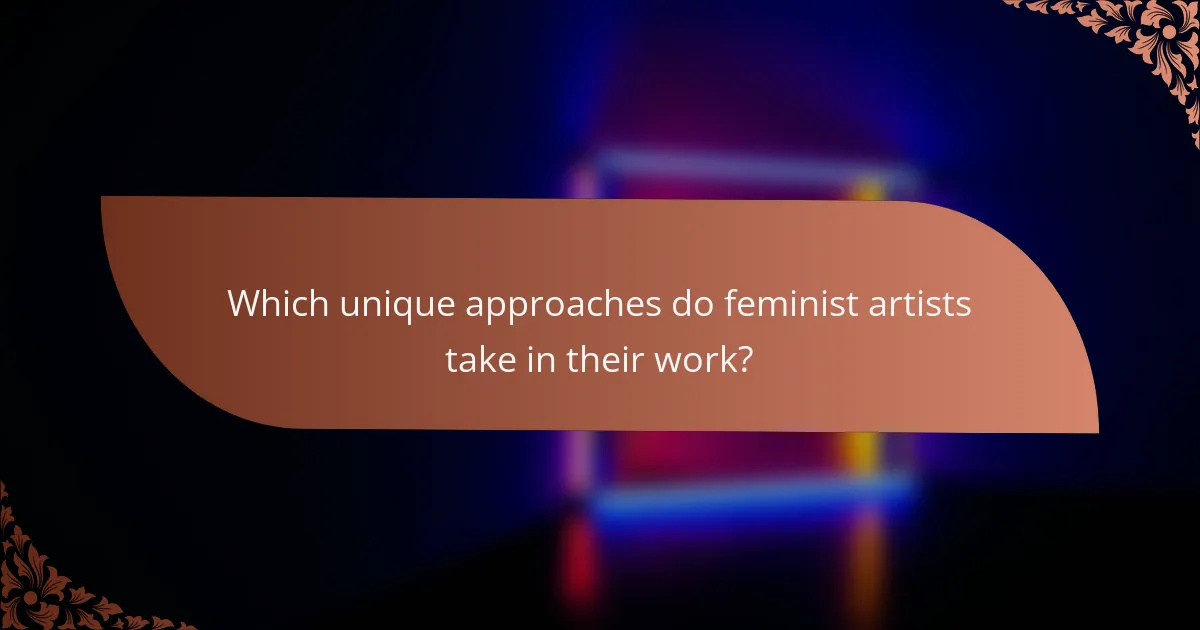
Which unique approaches do feminist artists take in their work?
Feminist artists often use unique approaches that challenge traditional narratives and empower marginalized voices. They incorporate personal experiences, activism, and diverse media to express themes of identity, gender, and social justice. For example, artists like Judy Chicago and Faith Ringgold utilize installation and storytelling to engage audiences and provoke dialogue. This approach emphasizes intersectionality, highlighting the complexities of race, class, and sexuality within feminist discourse. Additionally, many feminist artists adopt collaborative methods, fostering community engagement and collective creation, which further amplifies their impact on society.
How do feminist artists use multimedia to express their messages?
Feminist artists use multimedia to convey complex social messages and challenge traditional narratives. They often incorporate video, performance, and digital art to engage audiences emotionally and intellectually. This approach allows for diverse expressions of identity and experiences, enhancing the visibility of women’s issues. For instance, artists like Barbara Kruger use text and imagery to critique consumerism and patriarchy, while others like Pipilotti Rist blend technology and visual art to create immersive experiences. The integration of various media fosters a deeper connection with the audience, amplifying the impact of their messages.
What role does performance art play in feminist expression?
Performance art serves as a potent medium for feminist expression by challenging societal norms and advocating for gender equality. It allows artists to convey personal and collective experiences, often addressing issues like body politics, identity, and oppression. Through visceral performances, artists can evoke emotional responses, fostering dialogue around feminism’s diverse themes. Unique attributes of performance art, such as its ephemeral nature, enable a direct engagement with audiences, making feminist messages more impactful. As a result, performance art plays a crucial role in amplifying women’s voices and reshaping cultural narratives.
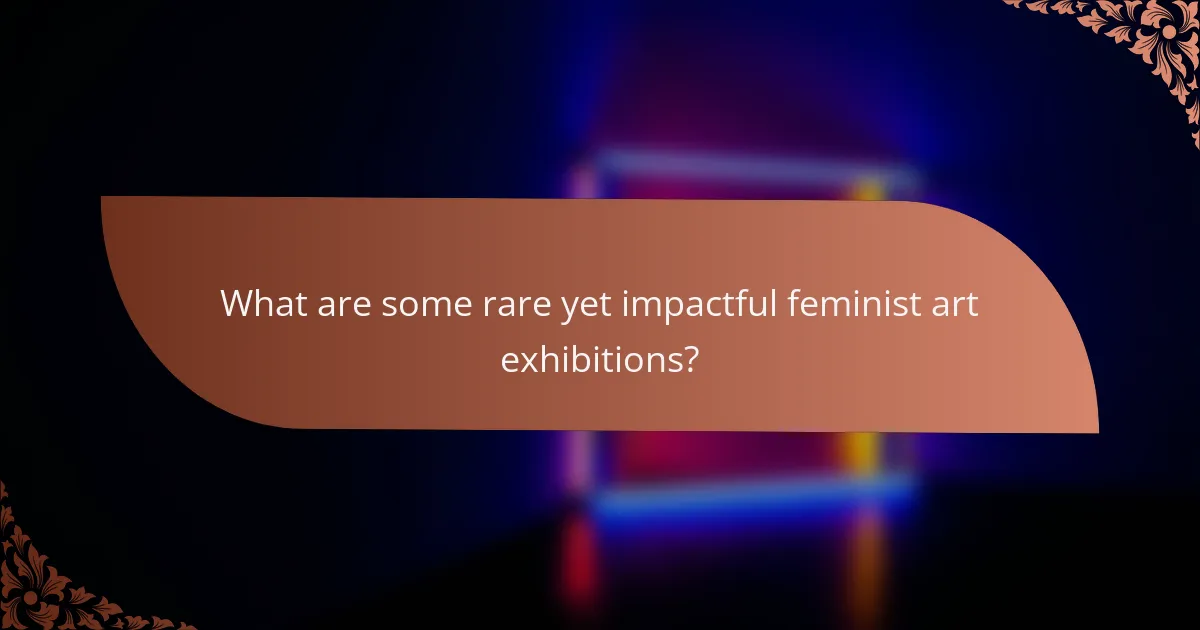
What are some rare yet impactful feminist art exhibitions?
Some rare yet impactful feminist art exhibitions include “The Dinner Party” by Judy Chicago, “Revolutionary Ideas” at the Museum of Modern Art, and “WACK! Art and the Feminist Revolution.” These exhibitions challenge traditional narratives and highlight women’s contributions to art. “The Dinner Party” features 39 place settings honoring significant women in history. “Revolutionary Ideas” focuses on feminist activism in contemporary art. “WACK!” showcases a diverse range of feminist artists from the 1970s, emphasizing the movement’s evolution. Each exhibition uniquely contributes to the discourse on gender and representation in art.
How do curated feminist art shows challenge mainstream narratives?
Curated feminist art shows challenge mainstream narratives by amplifying marginalized voices and presenting alternative perspectives. These exhibitions often highlight themes of gender inequality, identity, and social justice, which are frequently overlooked in traditional art spaces. By showcasing works from diverse artists, they disrupt the dominant cultural narratives and encourage critical dialogue. As a result, these shows foster a deeper understanding of women’s experiences and contribute to the broader feminist movement.
What makes the “WACK! Art and the Feminist Revolution” exhibition significant?
The “WACK! Art and the Feminist Revolution” exhibition is significant for its role in highlighting feminist art’s impact on society. It showcases key works that challenge traditional narratives and promote gender equality. The exhibition features pioneering artists who used their work to address social issues, reflecting the unique attribute of feminist art’s activism. By emphasizing themes of empowerment and identity, the exhibition fosters a deeper understanding of women’s contributions to the art world. As a result, it serves as a critical platform for ongoing discussions about gender and representation in contemporary art.
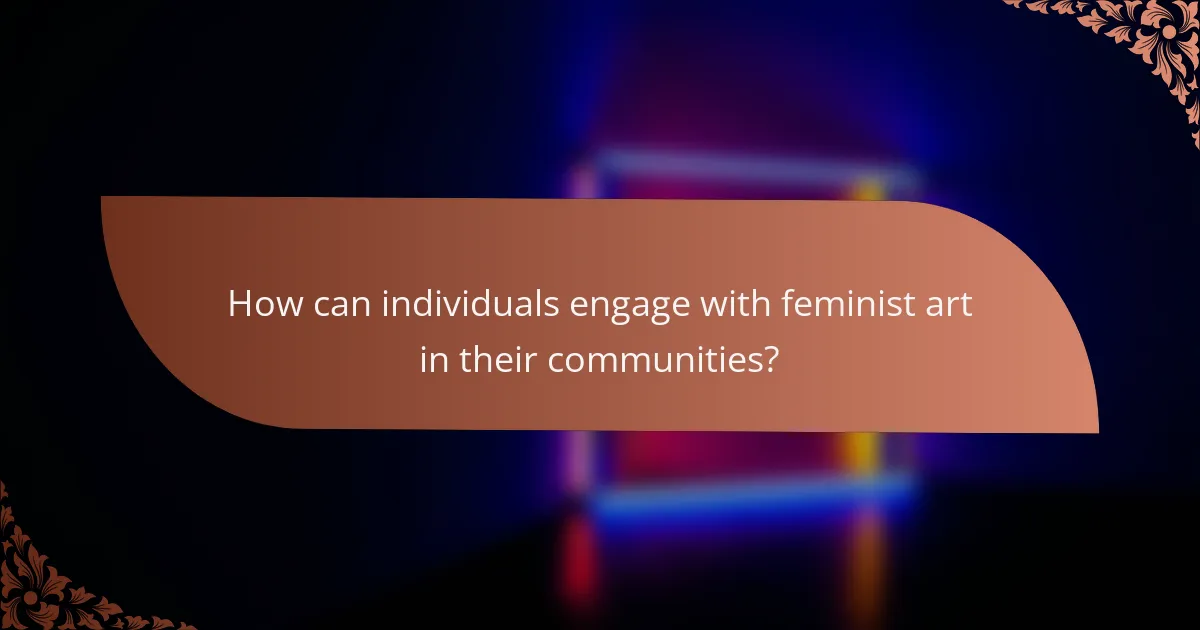
How can individuals engage with feminist art in their communities?
Individuals can engage with feminist art in their communities through various avenues. Participating in local exhibitions showcases women’s perspectives. Joining workshops fosters artistic expression and collaboration. Supporting feminist art collectives amplifies diverse voices. Attending discussions and lectures enhances understanding of themes. Volunteering for feminist art initiatives promotes community involvement. Each action contributes to the broader impact of feminist art in society.
What are effective ways to support local feminist artists?
Supporting local feminist artists can be achieved through various effective methods. First, attend their exhibitions and performances to show your support. Second, promote their work on social media to increase visibility. Third, purchase their art or merchandise to provide financial backing. Fourth, collaborate with them on projects or events to foster community. Lastly, engage in discussions about their work, amplifying their voices and messages.
How can art education incorporate feminist perspectives?
Art education can effectively incorporate feminist perspectives by emphasizing diverse narratives and critical analysis. Integrating feminist themes encourages students to explore gender representation and challenge traditional power dynamics in art.
Key strategies include analyzing works by feminist artists, discussing the impact of gender on artistic expression, and fostering an inclusive environment that values multiple viewpoints. This approach cultivates critical thinking and empowers students to engage with societal issues through art.
Furthermore, examining historical and contemporary feminist movements can provide context for understanding the evolution of gender in art. Encouraging collaboration on projects that highlight women’s contributions to art history reinforces the importance of diverse voices.
Ultimately, incorporating feminist perspectives enriches art education, promoting a more comprehensive understanding of cultural and societal influences on artistic practices.
What common mistakes should be avoided when interpreting feminist art?
Interpreting feminist art requires avoiding several common mistakes. First, do not generalize the message of the artwork; each piece often conveys unique perspectives and experiences. Second, avoid overlooking historical context, as understanding the time and place of creation is crucial. Third, refrain from dismissing the emotional impact of the art; feminist art often aims to provoke strong feelings and reactions. Lastly, do not ignore the diversity within feminist art; it encompasses various voices and styles that reflect different cultural backgrounds and identities.
